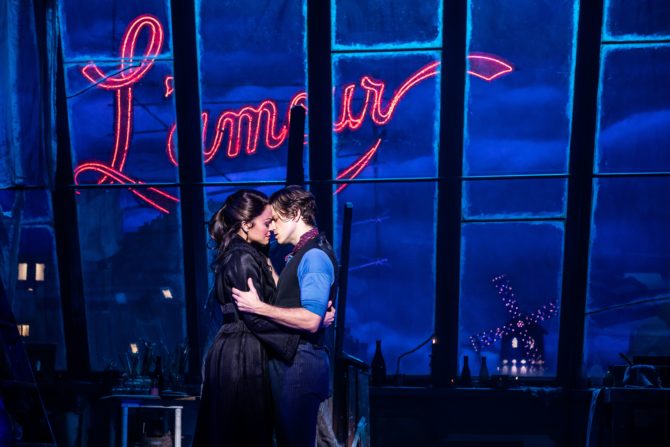Review by Elyse Trevers
If I had the time and the talent, I would write this review in song lyrics. I tried. I really did. And I spent hours Googling “lyrics that describe musicals,” “lyrics that have messages,” “lyrics that can be used as dialogue,” and more. But to no avail. However, my quest gave me an even greater respect for the creators of “Moulin Rouge: The Musical,” which got the rights to more than 70 songs for the exciting new show.
Based upon the 2001 romantic drama directed, co-produced, and co-written by Baz Luhrmann and starring Nicole Kidman and Ewan McGregor, the musical begins before the story officially starts. On stage, the performers, some scantily clad, move languidly across the stage. They stop, sometimes interacting with one another, all the while making eye contact with the audience. In an opening that’s hard to top, two female actors swallow swords as they caress one another.
The interior of the Al Hirschfeld Theatre is a feast for the eyes. It’s gorgeous, tawdry and decadent, consisting of red, nesting hearts. (Scenic design by Derek McLane). Unlike most theaters that prohibit taking pictures of the setting, “Moulin Rouge: The Musical” cleverly allows and even encourages it. And why not? First of all, people would have secretly taken pictures anyway. This way, many posted their photos online, creating free publicity for the show. The costume design, by Catherine Zuber, is sumptuous, lavish, and elaborate.
Then the music takes over. The opening number begins with energy and zeal as a quartette of sexy performers sing the first mashup of songs.-“Lady Marmalade/So Fresh, So Clean/Money (That’s What I Want)/Rhythm of the Night†/Because We Can.” The night I attended, the audience was excited, almost frenzied and every number and entrance was met with rousing applause, cheers and occasional laughter. It was excitement one rarely sees in theater except for known blockbusters like “Hamilton” or super stars like Bette Midler.
Directed by Alex Timbers, “Moulin Rouge: The Musical” is the ultimate jukebox musical, ironically as this genre of musical is losing appeal. This show doesn’t merely highlight the music of one group. Here characters speak in lyrics, sing fragments of songs and sometimes even entire songs from a multitude of artists, spanning decades, ranging from Georges Bizet and Edith Piaf to Katy Perry, Adele and Pink. The music is not only sung to advance the story; it sometimes creates humor. When Christian, the hero, first enters, two theatrical collaborators, Toulouse-Lautrec and Santiago are trying to write lyrics. They have part of “The hills are alive …” but they can’t finish it and keep inserting political messages. When Christian completes “The Sound of Music” lyrics, he is welcomed into their team.
The actual club, Moulin Rouge, was opened in 1889 at the foot of the Montmartre hill as a place for the rich to ‘slum it’ with the bohemians and common folks. The theater featured acts and performers. In the show, the star is Satine, here played by the wonderful Karen Olivo (“West Side Story”, “Rent,” “In The Heights.”) A victim of consumption, Satine will die by the end of the show. Olivo is sexy, lusty and beautiful, and despite her coughing, it’s hard to envision her ill. She’s electric, and when she makes her entrance on the trapeze and sings the mashup of diamond songs, “Diamonds Are Forever/Diamonds Are a Girl’s Best Friend/Material Girl/Single Ladies (Put a Ring on It)/Diamonds,” it’s impossible to take your eyes off her.
No wonder Christian immediately falls in love with her because so does the audience. Starring as the naive young American composer is Aaron Tveit, in what may finally be his break-out role. He’s come to Paris to get away and immediately impresses Toulouse-Lautrec (excellent Sahr Ngaujah) and Santiago (Ricky Rojas) with his composing ability. So they send him to win over Satine with music from their show. They hope she will convince the owner, Harold Zidler, to mount their musical at the Moulin Rouge.
Christian and Satine fall in love, but Satine has to give herself to the menacing, slimy but very rich Duke of Monnroth (Tam Mutu) to save the club. Despite the risks and Satine’s failing health, the two decide to carry on their affair, hoping that The Duke won’t discover them.
Together Olivo and Tveit have chemistry; they look good together, but, more importantly, they sound good together. As Zidler, Danny Burstein gives his usually strong performance,
managing to be funny, warm, even as he is sleazy.
And, of course, there’s the music. (Music supervision by Justin Levine). A few songs like “Roxanne” and “Your Song” are sung in their entirety but most of them are heard in short snippets. I found myself trying to identify each song and artist but sometimes the music was over before the next began. Unfortunately, the playbill lists the songs in alphabetical order.
“Moulin Rouge: The Musical” isn’t as much about the story as much as about spectacle -visually and aurally. The entire theater becomes the club, and, all of a sudden, the audience is in the midst of it. Although I saw the original movie, I can’t recall feeling as excited and energized about it as I was with the show. Theater can be more personal; it can touch and connect with the audience in ways that a movie can’t.
The show is reminiscent of “La Boheme,” and” Rent,” with the sordidness of Chicago and Cabaret. The music continues after the storyline ends with reprises of the more energetic numbers, so be sure to wait for the encores and applause. You’ll be singing on your way out; I know I was and strains of “Nature Boy” have been going through my head ever since.



